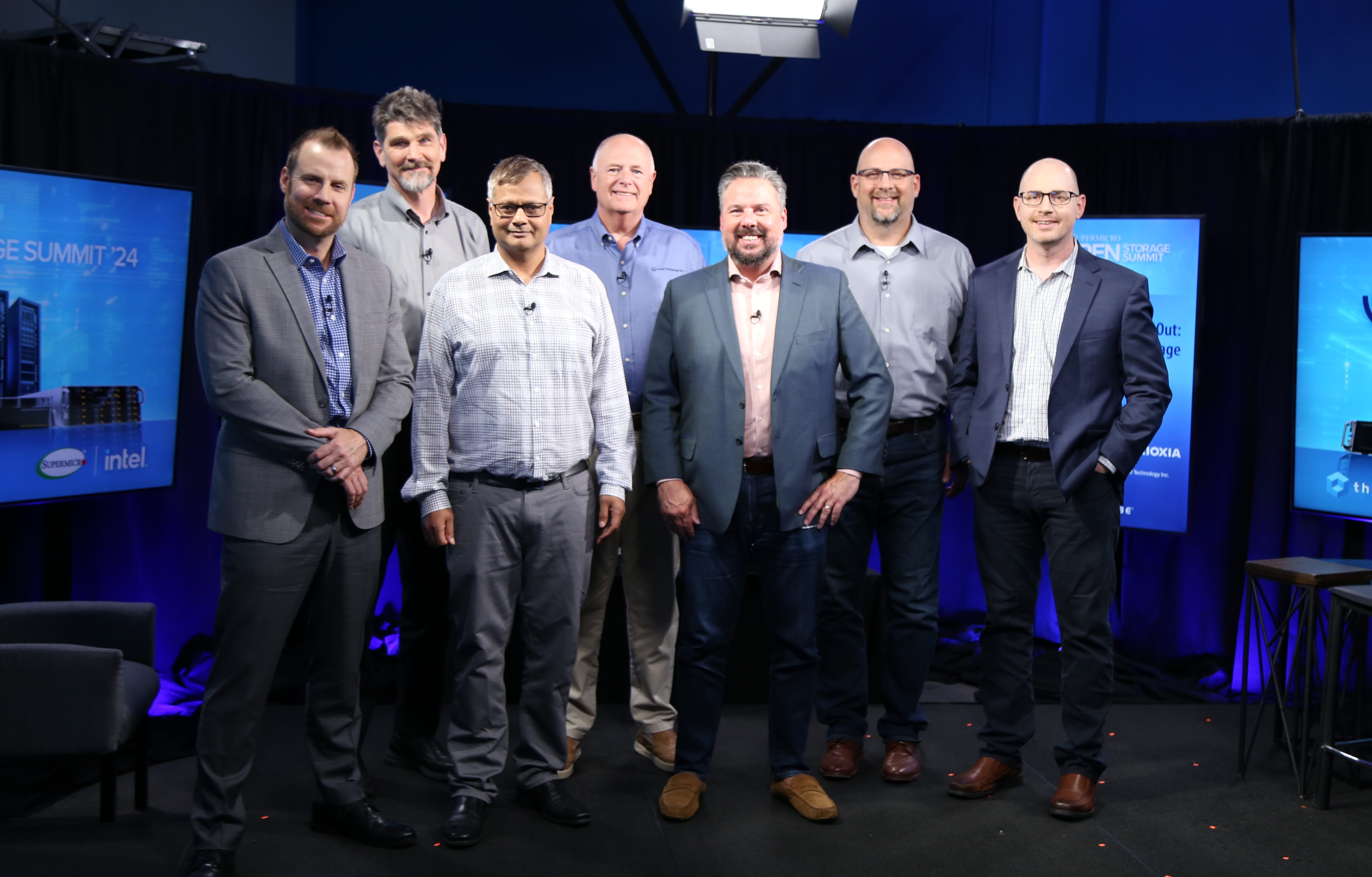 INFRA
INFRA
 INFRA
INFRA
 INFRA
INFRA
Today’s data-driven world means choosing the right storage architecture is crucial to enterprise IT strategies. Whether the aim is to expand seamlessly with minimal disruption or enhance performance without breaking the bank, it’s important to understand the distinction between scale-up and scale-out storage.

TheCUBE hosts an exclusive panel discussion on scale-up vs. scale-out storage with experts from Supermicro, Intel, Seagate, Kioxia America, OSNexus and Graid.
“We have this huge portfolio; some of these servers are designed specifically for compute,” said Paul McLeod (pictured, back row, left), senior field application engineer at Super Micro Computer Inc. “You get GPUs and things like that that can be very dense compute, and [for] other applications like storage, you’ll want to have something that is very dense. Our group is focused on these very high-density storage systems. One of the things that I think differentiates our product from the others is that we have a dual-ported system. It’s really designed for a scale-up type of architecture.”
McLeod spoke with theCUBE Research’s Rob Strechay at the Supermicro Open Storage Summit, brought to you by Supermicro, Intel, AMD and Nvidia, during an exclusive broadcast on theCUBE, SiliconANGLE Media’s livestreaming studio. Also joining McLeod in a special panel discussion was Iyer Venkatesan (front row, second from left), solutions marketing manager at Intel Corp.; Jason Zimmerman (back row, right), director of applications engineering at Seagate Technology LLC; Anders Graham (front row, left), director of marketing and business development for SSDs at Kioxia America Inc.; Steven Umbehocker (front row, right), founder and chief executive officer of OSNexus Corp.; and Thomas Paquette (back row, second from left), senior vice president and general manager of the Americas and EMEA at Graid Technology Inc.
The panel discussed the factors that impact scale-up and scale-out storage, from workload requirements to budget constraints and long-term scalability needs. (* Disclosure below.)
Scale-up storage refers to increasing capacity by adding resources (such as hard drives) to an existing system. This method is straightforward and often more cost-effective for smaller deployments. On the other hand, scale-out storage involves adding more nodes to a system, allowing horizontal expansion. Scale-out storage is ideal for organizations anticipating continued growth in data volume and the need to maintain performance across a distributed architecture.
“What we find is that most of our customers, especially in the enterprise, they’re going to use a scale-out architecture because you can scale both performance and capacity,” Venkatesan said. “It’s also more what we call standards-based. We have a lot of configurations and SKUs, so whatever [the customer] decides, whether it’s scale-up or scale-out, they’ll have to figure out what SKU best supports it for them because there are a lot of things that you can do based on the workload size, based on performance requirements, based on how much you want to do backup.”
OSNexus supports both scale-up and scale-out solutions, allowing customers to choose the most cost-effective option based on their workload. One of the company’s key innovations is its grid technology, which simplifies the management of multiple storage clusters across different data centers. This technology allows organizations to manage a combination of scale-up and scale-out configurations under a single system, reducing complexity and improving efficiency, according to Umbehocker.
“One of the reasons why we started OSNexus was to go and solve this management headache that organizations were having around having all these storage silos and five and six different products to go solve their storage needs,” he said. “With the grid tech, you can have multiple different clusters of storage in different data centers and manage it all as one.”
Mozaic and Heat Assisted Magnetic Recording technology represent Seagate’s latest storage innovation. These technologies are enabling higher aerial densities and larger capacities, doubling the potential storage capacity within the same physical space, according to Zimmerman. This is particularly useful for scale-out storage requirements, allowing businesses to start small and expand incrementally without disrupting workflows.
“Media physical grain size needs to be smaller to record more material or more data onto the disks without having it be unreliable and decay over time,” he said. “So physical hardness is required, and when the media is that hard, it’s a challenge to then write it. With heat assist, we’re able to take light, transform it into heat, change the magnetic properties of the media in nanoseconds, and then write the media with standard technology that Seagate has been using for years in perpendicular drives.”
Kioxia’s raison d’etre is optimizing SSDs for different storage architectures. Kioxia offers both enterprise-class SSDs with dual-port functionality for scale-up environments and cost-optimized SSDs for scale-out deployments, according to Graham.
“We have both memory solutions and SSDs,” he said. “We’ve been working with Supermicro for several years and gained a lot of traction with PCIe 4.0 SSDs, where Supermicro drove as first to market on their end through their server platforms. Then with PCIe 5.0, Kioxia was once again first to market with our data center SSDs just recently.”
Graid brings a novel approach to redundant independent disk arrays, designed to meet the demands of modern, high-performance storage environments. Its solution focuses on protecting mission-critical data in dense server environments, such as those used for AI and machine learning, according to Paquette.
“One of the reasons Supermicro took us on as a partner is because of the way that we perform in these all NVMe environments,” he said. “RAID is all about durability. We can scale up inside of a single server up to 32 drives. And because of the relationship we have with the drives, we can scale up very elegantly and very linearly inside of that server.”
Here’s the complete video interview, part of SiliconANGLE’s and theCUBE Research’s coverage of the Supermicro Open Storage Summit:
(* Disclosure: TheCUBE is a paid media partner for the Supermicro Open Storage Summit event series. Neither Super Micro Computer Inc., the sponsor of theCUBE’s event coverage, nor other sponsors have editorial control over content on theCUBE or SiliconANGLE.)
Support our mission to keep content open and free by engaging with theCUBE community. Join theCUBE’s Alumni Trust Network, where technology leaders connect, share intelligence and create opportunities.
Founded by tech visionaries John Furrier and Dave Vellante, SiliconANGLE Media has built a dynamic ecosystem of industry-leading digital media brands that reach 15+ million elite tech professionals. Our new proprietary theCUBE AI Video Cloud is breaking ground in audience interaction, leveraging theCUBEai.com neural network to help technology companies make data-driven decisions and stay at the forefront of industry conversations.